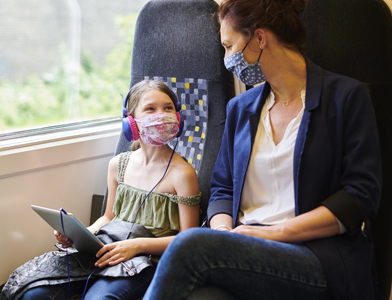Traveling for the holidays? Here’s how to stay safe.
To limit the risk of contracting or spreading COVID-19, travelers should take precautions, be prepared and follow guidelines.
With children as young as five able to receive Pfizer-BioNTech’s COVID-19 vaccine, it’s not surprising that families are ready to hit the road this holiday season to gather with loved ones they may have missed out on seeing last year. Centers for Disease Control and Prevention (CDC) guidance states that fully vaccinated people with an FDA-authorized vaccine or a vaccine authorized for emergency use by the World Health Organization can travel safely within the United States. But, with vaccination and case numbers varying state to state, what’s the best way to protect yourself and your family as you hit the road?
Two weeks after their second dose in a two-dose series, such as the Pfizer BioNTech or Moderna Vaccine/Spikevax COVID-19 Vaccine (Spikevax) vaccines
Two weeks after a single-dose vaccine, such as Johnson & Johnson’s vaccine
If you don’t meet these requirements, you are NOT fully vaccinated. If you have a condition or are taking medication that weakens your immune system, you may NOT be fully protected even if you are fully vaccinated. You ARE still considered fully vaccinated if you qualify for a booster shot but have not gotten it yet. In all cases, you should talk to your healthcare provider about your risk and follow all COVID-19 prevention precautions.
Make a plan
Before you go, check travel restrictions. For up-to-date information and travel guidance, check the state or territorial and local health department where you are, along your route and where you are going. Restrictions and policies may change during your travel, so be prepared to be flexible.
And, if traveling by air or train, check if your carrier requires any health information, testing or other documents.
Avoid shared spaces
The safest trip you can take is a short road trip with members of your household or fully vaccinated people. When you travel, you’re more likely to use shared spaces, such as restaurants, hotels and public restrooms, which increases your chance of contracting COVID-19. While the infection rate in your state may be low, it does vary nationally, and the risk of exposure is still very real. If you must fly, travel by train or take a long road trip, choose the option or route with the fewest layovers or stops.
Airports, train stations and large service stations are high-risk because many people from different areas move through a central location. Assuming appropriate precautions are taken, most viruses do not spread easily once you’re on a flight because of how air circulates and is filtered on airplanes.
It is safer to stay with fully vaccinated family members or friends or rent a vacation home than stay at a hotel with shared common areas.
One great thing about travel is the opportunity to dine out at places that aren’t part of your routine. But, the CDC warns that you should still avoid dining in poorly ventilated spaces and restaurants that don’t allow room for social distancing or in which the staff does not wear a mask. If possible, bring your food to prepare while away or stick to the drive-thru and curbside options, keeping your mask on while interacting with staff.
Follow CDC recommendations
Wearing a mask over your nose and mouth is no longer required on planes, buses, trains and other forms of public transportation traveling into, within, or out of the United States and while indoors at U.S. transportation hubs such as airports and train or bus stations. However, the CDC continues to recommend that people wear masks in indoor public transportation settings.
Visit the CDC website for full guidance.
The CDC recommends against international travel during COVID-19 for those who are not fully vaccinated—noting that even for vaccinated travelers, international travel poses additional risks of contracting and spreading COVID-19 variants.
For domestic or international travel, vaccinated persons should still self-monitor for COVID-19 symptoms after travel and get tested if symptoms develop.

For those traveling with children younger than five who cannot get vaccinated, the CDC suggests that everyone follow the recommendations for unvaccinated people, which are as follows:
Before travel
- Get tested with a viral test 1-3 days before your trip.
During travel
- Wear a mask over your mouth and nose.
- Avoid crowds and stay at least 6 feet/2 meters (about two arm lengths) from anyone not traveling with you.
- Wash your hands often or use hand sanitizer (with at least 60% alcohol).
After travel
- Get tested with a viral test 3-5 days after travel AND stay home and self-quarantine for a full seven days after travel. Even if you test negative, stay home and self-quarantine for the entire seven days.
- If you don’t get tested, stay home and self-quarantine for 10 days after travel.
- Avoid being around people at increased risk for severe illness for 14 days, whether you get tested or not.
- Self-monitor for COVID-19 symptoms; isolate and get tested if you develop symptoms.
- Follow all state and local recommendations or requirements.
The best way to stay safe while you’re traveling over the holidays and in your everyday life is to get vaccinated, mask up and keep a distance of 6 feet or more when you’re around others. If you are not yet vaccinated and are interested in learning more about the vaccine or finding a shot near you, CareFirst has you covered. Every person 5 and older is eligible to receive the vaccine.